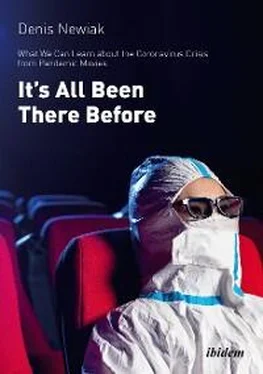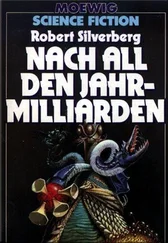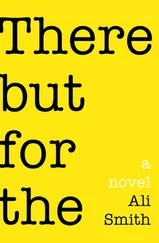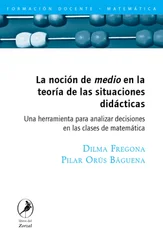I would like to thank my family, colleagues (especially my PhD supervisor Prof. Christer Petersen) and good friends who were willing to read parts of the manuscript written with a hot pen and to help me to bring the text into a reasonable form despite time constraints. While specialist publications like to take a little more time (for good reasons), I would like to thank the publishing house for the fact that in this particular case everything was done – even under the current difficult conditions – to put the book out so quickly that it still reaches its readership as long as we all have to struggle with this great challenge. The guidance offered by the movies and shows may also prove helpful should we again be confronted with a pandemic in the future. Perhaps we can surprise ourselves once again by emerging together stronger from this to date biggest test of the 21st century, and then tackle the other pressing social, environmental, and political problems together.
Denis NewiakPotsdam, Germany, June 2020
Translated in May 2021
The warnings and advices of the pandemic cinema
Unexpected challenges of Coronavirus pandemic:
How to take a decision?
The pandemic outbreak of the novel Coronavirus in the winter of 2019/20 has impressively and momentously demonstrated how demanding it can be for politics, the economy and civil society to make sufficiently reliable predictions of disruptive future events: the rapid spread of Covid-19, the severity of the disease and the rapid rise in the number of sick people and deaths, the resulting supply gaps and the rampant speculation, the very sudden cuts in fundamental rights, border closures and the resulting reservations among the population, the spread of false information, social isolation and domestic violence in quarantine – all these and many other problems have created considerable difficulties for societal decision-makers, who have been ‘surprised’ by those challenges and did not know ad hoc how to deal with them in a meaningful and responsible manner. This uncertainty has resulted in farreaching consequences, for example, because important protective equipment for medical personnel has been missing and profiteers have wanted to benefit from the emergency. Coercive measures and uncertainties associated with the situation lead to financial and psychological burdens for the population – and thus to social tensions, like extremist populism and conspiracy theories.
Pandemic warnings in film and television are more vivid than through experts and authorities
For a long time, the spread of dangerous infectious diseases has not only formed the basis for an unmanageable number of entertainment films, not least in zombie and alien cinema, but also (with a notable increase in the past decade) in more serious dramas that deal with the social consequences of such a plague. In these fictional worlds, the virus pandemic becomes both an allegory that represents other undesirable social developments and an expression of a real danger, which virologists, epidemiologists, and civil protectionists have always warned against. However, the appeals by experts for better pandemic preparation and aftercare to politicians have largely gone unheard: the dangers of an outbreak seemed unlikely, theoretical, and controllable – with the visible consequences. At the same time, the vivid pandemic fictions in film and television have created a considerable potential for conveying future and behavioral knowledge that may now prove useful: the astonishingly concrete popular images for their narratives, for example of sports halls converted into emergency hospitals (cf. fig. 1), appear, from the present perspective, almost as prophetic warnings of the real dangers of a pandemic, which have already materialized in film and television long before that. Interestingly, film and TV develop their own ideas within the fictional narrative world as to which behavioral options are useful in such a crisis.
Transfer of knowledge and meaning through film and television allows communication and organization of a society
Films and television series impressively demonstrate that – despite and precisely because of their speculative character, the artistic freedoms they are granted and their tendency to deal with unlikely scenarios – they also serve, beyond their entertaining and commercial potential, as a system of dynamic social discourse and knowledge transfer, “as a central place of social selfunderstanding” (HICKETHIER 2008, 47). Through the macrosocial communicative mediation processes set in motion by film and television, meaning is produced, discourses of what is real and unreal circulate through society, and truth is stabilized as a common sense. Thereby, together with the other modern mass media, visual media gain enormously in communitybuilding power: mass media serve the “conducting of selfobservation of the social system” (LUHMANN 1996, 173) and the “constant production and processing of irritation” (LUHMANN 1996, 174), i.e. an uninterrupted rearrangement, selection and normalization of social realities through communication. Even if this dominance of the media in the social production of meaning is sometimes disturbing, only this constant dynamic updating of the social consensus makes it possible – especially under the rapidly changing living conditions of a highly complex late modernity – to always find an intersubjective basis on which as many members of society as possible can agree. Only on this basis of a shared reality, we can interact and communicate with each other meaningfully and thus organize and shape our living together as a society.
Film and television convey suggestions for appropriate behavior and allow social modernization
Film and television provide their viewers with orientation in modern times of constantly changing certainties and dwindling securities: They convey to the recipients “a knowledge of it and at the same time a feeling for what is historical, social and cultural present beyond their own living environment [...], what is possible and impossible here and now, tempting and repulsive, urgent or indifferent” (KEPPLER 2006, 316-317). In this context, cinematic art also conveys an understanding of what appears right and wrong under the respective given conditions, what is to be evaluated as appropriate and inappropriate: “The ensemble of characters plays through behaviors and opinions of different kinds, which are juxtaposed and presented to the audience on individual themes, and which have to prove their suitability”, i.e. they have to prove themselves in dealing with the respective social challenges the fictional characters are confronted with (HICKETHIER 1994, 67). The fictional characters also indirectly make concrete behavioral suggestions as to how one could act as a television viewer within the framework of one’s own real-world lifestyle: with the help of the fictional behavioral fragments, individual and social problems can be individually solved. Film and television thus participate in conveying meaning and modelling action for the increasingly complex living conditions of late modernity. They become the most important subsystem of “social modernization processes”, a “place where the behavioral models necessary for modernization are offered and disseminated” (HICKETHIER 1994, 70): the cinematic arts make it possible to adapt to new and thus unknown modern situations of interaction, to emerge from them as successfully as possible and to circulate this knowledge in modern society. This important societal function of TV and cinema can be understood best if you compare it to socalled “social media”: “social network” platforms on the Internet primarily tend to reproduce highly stylized illusory realities in an individualized bubble, to give preference to extremely emotionalized, advertisingeffective content and polarizing, hardly controllable disinformation. Motion pictures and television series, on the contrary, effectively help to correct outdated moral concepts, clichés, and prejudices, to present options for action for demanding contemporary life situations that the recipients can accept or reject. In doing so, they point out otherwise invisible and underrepresented lines of social conflict. Cinematic art forms thus hold together an otherwise atomizing, constantly isolating, individualizing and accelerating modernity by maintaining the subjects’ feeling that life in community can still be influenced and desirable changes can be realized.
Читать дальше












